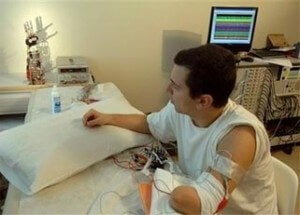
Scientists are becoming increasingly adept at creating machines that can successfully attach to your neurons. In the realm of prosthetics, the ultimate artificial hand is one that can accept commands directly from the user’s brain and transmit sensation back. At the Universita Campus Bio Medico in Rome, surgeons connected wires from the nerves of an amputee named Pierpaolo Petruzziello to an artificial limb called Life Hand. Over a month, Petruzziello was able to move the mechanic limb in gestures more complex than any previous device has accomplished. Researchers report that the Life Hand obeyed about 95% of the commands mentally sent by Petruzziello. This remarkable success was possible even though the hand itself was never implanted onto the patient. Check out the videos from the Associated Press and Discovery News after the break.
If the specifics of Life Hand are giving you a mild sense of deja vu, you’re not alone. In late October I reported on Smart Hand, a similar device tested in Sweden on a different young man – Robin af Ekenstam. The two projects are actually related. Both were part of a larger EU task force working on artificial limbs. If the Life Hand and Smart Hand look nearly identical, that shouldn’t be surprising either, considering that both were constructed at the Scuola Superiore di Sant’Anna in Italy. The largest difference between the two devices (besides the name) is that the Smart Hand is taking steps towards implantation, while the Life Hand is focusing on the complexity of gestures and reliability of signals to/from the device.
It’s a little strange that each innovation in science and technology is presented as a completely separate achievement in the major media outlets. The work done in Sweden and Italy for these artificial limbs is related and enjoys a healthy level of collaboration. Which is good news for those interested in one day owning an artificial limb. The more that data is shared between these groups (and their competitors from around the world) the quicker we’ll see a device that can accurately replace a human hand. However, as we discussed with Deka’s Luke Arm and DARPA’s Revolutionizing Prosthetics program, such a hand may be too costly for most people to afford for years after it debuts.
Eventually though, the price of prosthetics will decline just as all other accelerating technologies tend to do. And I think the Life Hand definitely shows that prosthetics is an accelerating technology. The degree of gestures that it can perform is very promising, even if, as Petruzziello has joked, those gestures were sometimes obscene.


